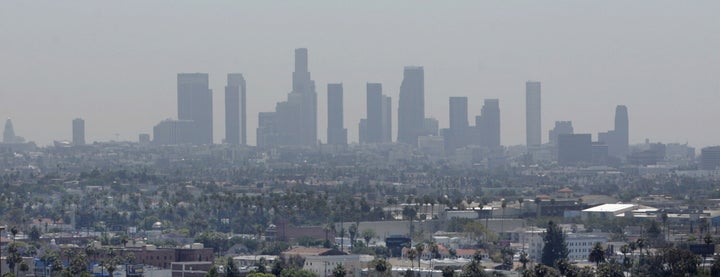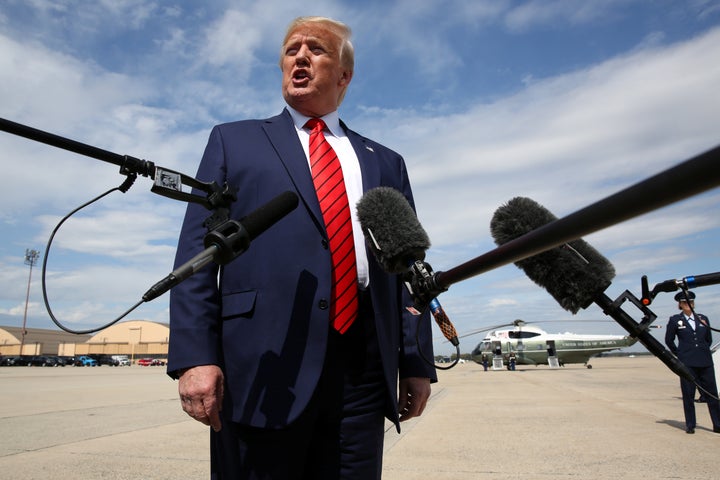President Donald Trump spent his week skulking around a United Nations climate summit, teasing a teenage activist with Asperger’s syndrome, and preparing for an impeachment inquiry.
His top environmental regulator, meanwhile, used the week to threaten California. The head of the Environmental Protection Agency publicly chastised the state’s governor over the “piles of human feces” befouling the streets and sidewalks of the state’s cultural capitals and suggested what The Washington Post called a “rarely used federal punishment” in response.
The statements, made in public letters to top California officials, are a sign of things to come as the administration seeks to shore up its deregulatory advances and deliver talking points for an unpopular president ahead of the 2020 election. The climate crisis ― and Trump’s failure to address it ― are likely to be a top focus. So his administration is turning its sights elsewhere: California, a blue state and frequent Trump punching bag.
EPA Administrator Andrew Wheeler sent the California Air Resources Board a letter Monday accusing the state air regulator of failing “to carry out its most basic tasks under the Clean Air Act.” He also suggested the administration could take the unusual step of pulling California’s federal highway funding.
On Thursday, Wheeler blamed California Gov. Gavin Newsom for stoking “a homelessness crisis that now threatens human health and the environment,” demanding the first-term Democrat produce a cleanup plan in the next 30 days.
The pollution wasn’t new in California, but then again neither were the threats. Since historic wildfires scorched the state last year, Trump has repeatedly threatened to cut off federal aid. What’s changed, experts say, is the political context of the administration’s saber-rattling.
Not My Voters
“California gives Trump more gusto,” said Michael Gerrard, the director of the Sabin Center for Climate Change Law at Columbia University. “He’s rolling back environmental regulations across the board, but he’s especially enthusiastic about sticking it to California.”
The Golden State has long served as a liberal straw man for conservatives to torch. For over a decade, Republicans have run ads routinely accusing Democratic opponents of espousing “San Francisco values.” But whereas that charge carried a more loaded meaning during the fight over same-sex marriage in the mid-2000s, today it’s a stand-in for “not Republican.”

The state that gave the nation Richard Nixon and the Reagan Revolution relegated Republicans to a third-party status last year as new registration data showed independents eclipsing the GOP by 73,000 voters, making it the second largest bloc behind the Democrats, Politico reported. Just 29% of likely California voters said they planned to vote for Trump in 2020, compared to 67% who said they didn’t, according to a University of California, Berkeley Institute of Government Studies poll published this month. That, The Los Angeles Times wrote, puts the president on track for the “poorest showing by a Republican presidential candidate in the state since the Civil War.”
So for a president who rallies his base by bashing its perceived enemies, it’s a convenient reality that the road to gutting former President Barack Obama’s signature clean car rules runs through California.
Road Rage
It started in 2017, when the EPA started the process to unwind the Obama administration’s rule cutting tailpipe emissions. The regulation, which automakers endorsed in 2012, required passenger vehicles to average 54.5 miles per gallon by 2025 ― roughly double today’s standard. If fully implemented, the program would reduce oil consumption by 12 billion barrels, halve tailpipe pollution and double fuel efficiency, saving drivers $3,200 to $5,700 in gasoline costs over a vehicle’s lifetime.
A year later, the EPA proposed reversing the rule, arguing that Americans’ taste for gas guzzlers meant new car sales would fall, as federal rules required manufacturers to sell more fuel-efficient models. Freezing emissions standards at current levels, the EPA said, would spur more consumers to buy newer, safer cars.
California foiled those plans. The state’s geography makes its biggest metropolis uniquely susceptible to smog and ozone. To address this problem, Congress gave California the right under the Clean Air Act to set its own pollution standards. Citing the agency’s own 2009 finding that carbon dioxide qualified as a pollutant under the Clean Air Act because it caused health-harming climate change, California refused to loosen its tailpipe emissions standards.
That put the Trump administration in a bind. After shredding nearly every other major Obama-era greenhouse gas rule, the auto emissions regulation marked a final obstacle. But the Obama administration had brokered the rule as a compromise between California regulators, who wanted an even more aggressive federal program, and automakers, who conceded on mileage in the spirit of gaining a strong national standard, averting the costly need to build vehicles to two separate standards.

With no deal in sight this summer, California regulators struck an agreement in July with four auto giants ― Ford, BMW, Honda and Volkswagen ― to stick to existing standards. In the first week of September, the Department of Justice opened an antitrust probe into whether the four companies’ deal with California violated competition laws.
Weeks later, the EPA proposed formally revoking California’s Clean Air Act waiver.
‘We Keep Winning’
Forcing California into submission, however, is about more than just tailpipe emissions.
In the early 1970s, under then-Gov. Ronald Reagan, state lawmakers commissioned a study on how to serve California’s growing population with electricity without dotting the coastline with power plants. The result were energy efficiency mandates that reduced California’s fossil fuel use per unit of economic output by 70%, a figure 10 percentage points higher than what the the other 49 states achieved, according to a Natural Resources Defense Council report published last year.
If “the rest of the nation had improved as quickly as California has between 1975 and 2016,” wrote Vox’s Dave Roberts, U.S. “greenhouse gases would be almost 25% lower.”
The success of that policy agenda stands in stark contrast to the Trump administration, which appears ideologically opposed to energy-saving measures. Earlier this month, the president reversed energy efficiency rules on lightbulbs, bizarrely arguing that energy-saving bulbs cast his skin in an orange light.
California Attorney General Xavier Becerra seems emboldened by victories. His office sued the White House for the 62nd time on Wednesday, this time to block a rule weakening endangered species protections amid a mass extinction. For comparison, Texas ― whose Republican attorney general (now governor) sued the Obama administration so often he bragged, “I go into the office, I sue the federal government, and I go home” ― only filed about 50 lawsuits during the Democrat’s eight-year tenure.
Becerra hopes the odds in the tailpipe emissions fight are in its favor, too. A New York University School of Law report last year found that the EPA lacks the legal authority to withdraw the congressionally granted waiver, and no president has ever tried.
“So far, whenever someone comes at California, we’ve had pretty good success,” Becerra said by phone Thursday. “We keep winning.”
